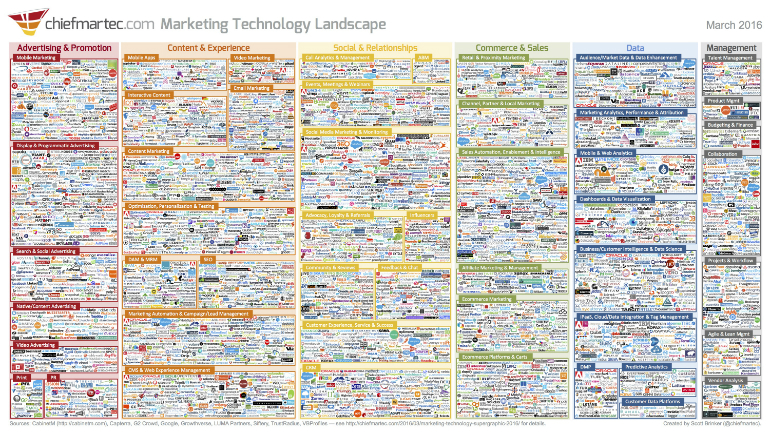The race to adopt the latest marketing technology has enthralled us.
But in our excitement, there is a risk that we lose sight of what really makes it work – the data that underpins every new platform, tool or channel and drives true marketing success.
Supergraphics, such as the one compiled by Scott Brinker (below) are mesmerizing. Spend a moment looking at the wealth of technology available to B2B marketers and it’s easy to think that nothing is beyond us if only we could squeeze it all into our budget. The obvious decision, therefore, is which one to invest in. Which one is the silver bullet? Which one is going to transform our marketing process, turning our old-fashioned marketing funnel into the sleek, gleaming lead machine it should be?
The answer is none of them. Or any of them. Drag your eyes away from the dazzling display of logos and instead consider the real secret to your success. Your data.
Is there something we’ve forgotten?
Marketing seems to have neglected the data. This oversight has contributed to our inability to achieve all those goals that we had when we began this journey. We thought technology would help us measure channels, and predict which ones drove the best quantity and quality of leads. We thought it would create an integrated, buyer-centric, omni-channel customer experience. We thought we’d be better aligned with sales, with greater reach, and more optimized marketing spend. We thought batch and blast campaigns would be a thing of the past, replaced by cleverly personalized buyer journeys.
Yet, here we are, 15 years after the appearance of the first automated email platforms, and most marketers are unable to claim to have successfully cracked any of these things. We suspect the reason lies with the data, not the technology.
More, not better
One key factor is the sheer volume of data. Every new tool or platform generates still more data, but (because they are typically designed to perform a particular function) they are not equipped to unify the customer records in any meaningful way. Clients now have a marketing architecture so out of alignment at the data layer that it can feel paralyzing; an already complex data environment gets more baffling and impenetrable by the month.
Marketing used to have it easy when it came to lead data, with the linear workflow of a marketing responder/lead (basically a contact record with a marketing campaign ID) being sent to sales to be converted to an opportunity or rejected. The lead would come back into the workflow once marketing generated a new response from the contact and we would measure the process again as if the previous process never occurred. Now thanks to the technology explosion in marketing, there is an entire ecosystem of marketing-led interactions happening at all phases of the buyer journey – before, during and after purchase.
The irony is that many of these are not necessarily new types of transactions, they are just now happening more often and the data is more available to marketing – leading to a big analytics problem. Marketing has to try and measure what works and what is the right mix of campaigns to run with an almost infinite number of buyer paths and behaviors to interpret.
Every new marketing tool generates more data – but none is equipped to unify customer records or fully integrate with other data sources.
Where are all the data analysis skills?
If you have access to a data warehouse, you are one of the lucky few. You can get all buyer data and transactions into one place and you have maybe taken some interesting steps toward understanding the buyer from a data perspective. However, you might also be realizing after that huge effort there is still a lack of resource to on-board, categorize and align new data so that it can drive reporting insights and actionable analysis to feed back into the marketing planning function.
When marketing gets an answer to one question, it typically leads to several more. Most internal data warehouse teams are not staffed with enough dedicated data architects, engineers and analysts to support the constant flow of requests coming from marketers seeking to stay ahead of the competitive curve.
5 key sources of B2B data
To help bring this into context, let’s consider five common B2B data scenarios:
1. Events
Whether it’s a tradeshow or a webinar, events are one of the most common sources of “marketing leads” in B2B marketing. Sales wants to get their hands on them, marketing wants to nurture them, but the way the data is captured is a problem. Tradeshow leads, for example, often lack key details such as email. They are uploaded into the CRM but additional steps (and funds) are needed at some point to append email. Online events – especially when hosted by third parties – present their data in a different format. In many organizations we’ve come across, event teams are siloed from the rest of the marketing team, leaving leads marooned in a dedicated events database or – even worse – allowed to decay on someone’s desktop. Either way, we have multiple potential locations for storing event attendee data, and periodic requirements to enrich and normalize it to make it work together.
2. Web Sites
Websites can be integrated with marketing automation platforms (MAPs), which enables automated response and the potential to nurture. But a MAP is not set up to append account data to the leads as they convert – meaning everyone gets the same experience and content, whether they are a customer or prospect. Some companies have invested additional budget in tools like DemandBase or Reachforce to address this problem, only to find that those tools are only as good as the third party data and the ability to align that third party data with first party data.
Website activity data, measured by your web analytics tool, can tell you where web visitors land, where they leave, and what they look at inbetween. But this is not typically accessible through your MAP, which only stores it for the purposes of scoring and triggering automated activity.
The rich meta data that helps marketers understand the effectiveness of messaging and content in context remains in your web analytics tool and represents yet another data source that needs to be extracted and linked with MAP and CRM campaign data externally.
Web data helps marketers understand individual customers – but only if it isn’t stuck in your web analytics tool.
3. Email
Understanding how email activity, including nurturing programs, impacts revenue is one of the most common challenges facing marketers – especially those trying to justify the investment in a marketing automation platform. But the data challenge is that email increases the amount of “transactions” associated with a contact – which is more than most CRMs can cope with. Even if you were to push email metrics into CRM – most marketers want to measure unique email engagement and that requires a process to aggregate and de-dupe the activity data with timeframe and content context. So maybe you try to pull the sales data back to the MAP (which some MAP vendors promise as being the path to closed loop reporting – LOL), but then you realize something; all your email efforts impact pipeline and all your pipeline is impacted by email. This both dilutes and over reports how email impacts revenue – so it becomes meaningless in terms of actionable analysis.
With this example, maybe we did not add another data source to the problem, but what we can see is how volume of data can cloud the analysis of buyer engagement and sales impact, and the difficulty of doing analysis through the MAP or CRM reporting tools.
4. 3rd Party Data
For a while the use of third-party data was put on the back burner in favour of the MAP investment (I include tele-prospecting and profiling in that mix too), but there is a shift back to investing in these resources to try and cover up the lack of return attributable directly to the MAP. However, the value of third-party data can be compromised by the difficulty in integrating it with your own data. For example, if the third party data is not aligned to your taxonomy, it may not be immediately obvious if you are buying a lead you already have. Then using the data is a challenge because it is not actionable for the processes you have designed for scoring, automated nurturing, etc.
So while you might see a short-term bump in qualified leads, you will struggle to generate returns in the long-term – and before long, the cost of generating these short-term leads will have you thinking it’s 2002 again.
Third-party data is increasingly seen as a way of covering up the lack of return from marketing automation platforms.
5. Sales
This type of customer data is typically sitting in a CRM, ERP or maybe an e-commerce platform. It also typically represents the most accurate information about the account that should be leveraged by marketing, including headquarter and subsidiary purchase history and valuable profiling information. It is also probably the data that marketing uses the least when managing its own database – mainly because marketing tools are not designed like CRM and ERP. They lack the ability to store account and purchase history data and integrate it with the vast amounts of marketing data they collect at an individual contact level.
Sales-generated data can be critical to understanding true buyer behaviour and helping work out whether you’re speaking to a cold prospect, a recently acquired customer, or a loyal advocate. Without this insight, marketing is limited in its ability to promote the most appropriate products and solutions, or to address the individual in the most relevant, meaningful way.
When marketing automation came on the scene it forced sales and marketing to get more aligned as they tried to integrate the MAP and CRM. However, the key success factor of integrating customer data and making it available to marketing early in the engagement process is still lacking for many of our clients. Marketing ends up analyzing only one side of the equation – campaign and content activity – and is unable to provide actionable insight to sales about existing customers trying to educate themselves using marketing content designed to generate new leads. The workflow between MAP and CRM may run smoothly – but without that level of data integration, sales and marketing are still far apart when it comes to identifying what is a lead and what is not.
These are five common scenarios that will be familiar to all businesses – which means that marketers in all industries and geographies will face similar problems: there’s plenty of data there, but until it is unified it remains frustratingly difficult to use.



